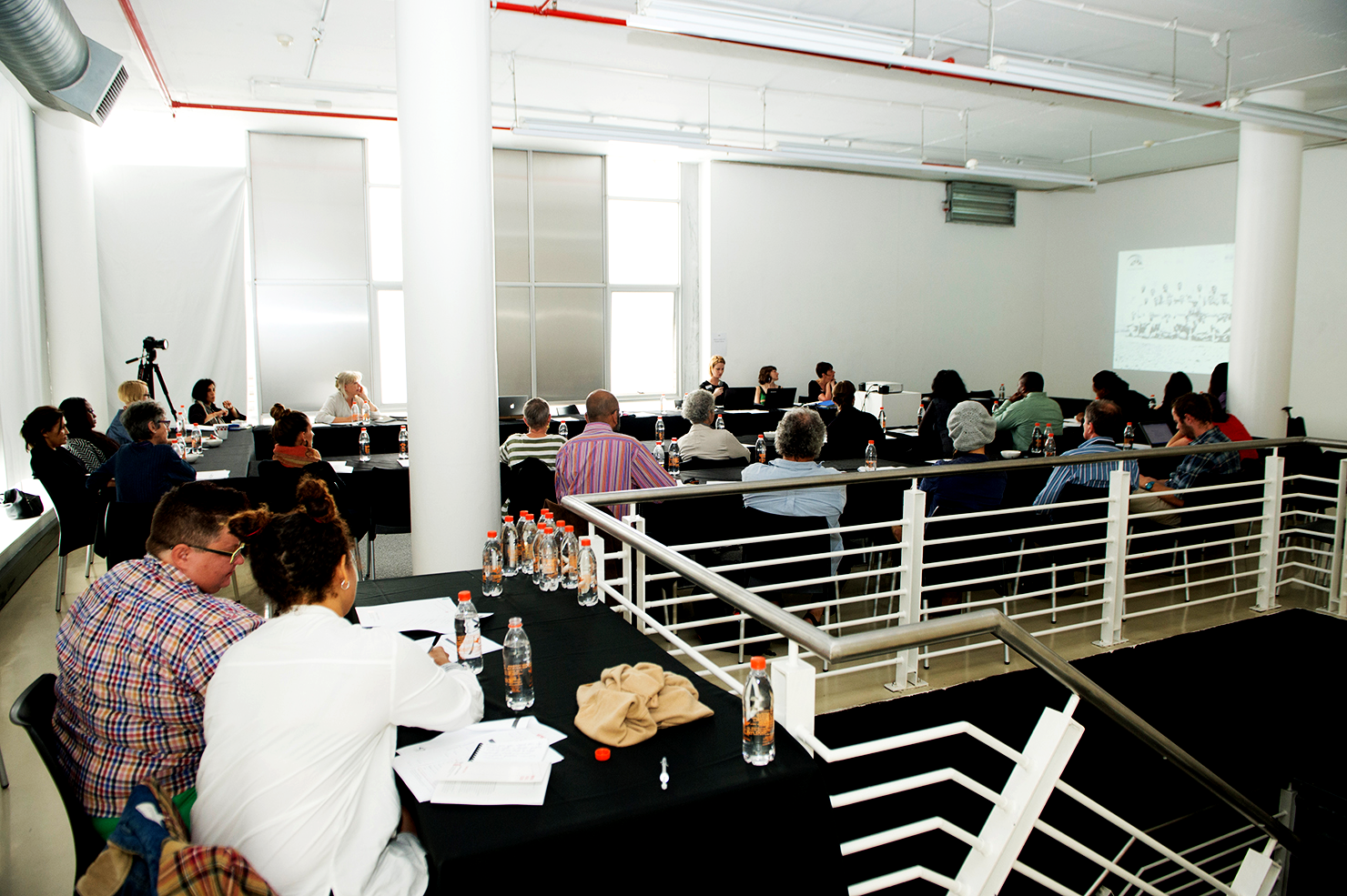ARCHIVAL ADDRESSES: PHOTOGRAPHIES, PRACTICES, POSITIONALITIES
18 - 20 March, 2015 | FADA Gallery, University of Johannesburg
VIADUCT 2015 offers a platform for a series of papers, panel discussions, artists’ presentations, film screenings and an exhibition engaging with the complexities of contemporary archival practices, and how these play out using lens-based and new media technologies (hereafter loosely termed photographies’). In VIADUCT 2015, participants consider contemporary possibilities for, and practices of, addressing archives; how these possibilities might impact on how archives are collated, disseminated, accessed and received; and what implications they may have for understanding the functions, meanings and significance of archives in diverse contexts. Although it is widely scoped, covering a broad range of contemporary addresses and multiple archival forms, VIADUCT 2015 is not intended to provide a ‘snapshot’ of either. Rather, in selecting a particular group of participants and highlighting the diversity of their practices, we focus on bringing into view a (thin) sliver of archival addresses currently being undertaken.
The platform thematic suggests a range of possible archival addresses that participants ‘work through’ in discussions, conversations, and engagements. Platform participants – who include archivists, academics, artists, filmmakers and curators – address archives either through their own research practice or with reference to the work of other archival practitioners. In speaking about, writing on, engaging with, or referring to, archival materials, participants may be considered as archival ‘practitioners’ in as much as the archival practitioners whose work they address. Charles Merewether (2006:10) notes that as “the means by which historical knowledge and forms of remembrance are accumulated, stored, and recovered”, the archive[1] may be one of the defining characteristics of the modern era. While VIADUCT 2015’s thematic is grounded in, and its conceptual framing draws on, the vast context of scholarly work done on the archive,[2] the archive is not considered as a discursive form in and of itself, but rather as a dialogical site of address through which identities and subjectivities are activated, constructed and contested. In VIADUCT 2015, use of the term ‘addresses’ is intended to connote dialogic processes of exchange, specifically:
i. dialogic acts of speaking of, to and ‘with’ the archive (dealing with, attending to, focusing upon, taking up);
ii. dialogic and/or practical engagements with archival materials (drawing on, working with, reading into, intervening with, reacting to, interpreting and reinterpreting, reframing, reconfiguring, reactivating, reanimating, re-appropriating and unsettling);
iii. referential acts (references to, pointing or gesturing towards the archive).
Furthering VIAD’s broader research thematic for 2015-2017, ‘Performing the everyday: visualities, identities, subjectivities, positionalities’, our contribution to this well-established discourse is through emphasis on the role of what Stuart Hall (1996) terms ‘positionality’. Positionality is examined in relation to the construction of identities and subjectivities of practitioners, those subjectivities present within the archive itself, and ways in which all of these subject positions are activated. As Hall (1996:210, 211) states, [t]he practices of representation always implicate the positions from which we speak or write – the positions of enunciation … though we speak … ‘in our own name’, of ourselves and from our own experience, nevertheless who speaks, and the subject who is spoken of, are never exactly in the same place. … What we say is always ‘in context,’ positioned.
The location of addressor and addressee – where their subjectivities are positioned literally and figuratively – the address of the address (home, site, space and/or place; relationships between particular historical, political, geographic, social and cultural circumstances and contexts) – informs the dialogic processes of exchange. The platform’s format is designed to encourage interaction and exchange between a small, select group of practitioners. The focused nature of the group allows for a dynamic interplay between:
i. the multiple subjectivities of the practitioners;
ii. the individual and collective subjectivities of those represented;
iii. the subjectivities of the photographer or archivist;
iv. a plurality of addresses – acknowledging that addresses are dependent on multiple, shifting subject positions within one or more speakers, and the interchanges between them;
v. ways in which subjectivities embodied in the archive ‘speak to’ each of the above.
In VIADUCT 2015, practitioners’ multivalent positionalities are foregrounded through:
i. interaction and exchange by participants working in multiple global contexts;
ii. addresses that span a cross-section of archival practices taking, or having taken, place in multiple historical, temporal, spatial, cultural and geographic contexts (South Africa; Nairobi, Kenya; Abidjan, Cote d’Ivoire; Birmingham, England; the American Jim Crow South);
iii. considerations of archives located in conditions of political and social turmoil or set against, and within, the fraught legacies of colonialism and apartheid;
iv. practitioners’ often deeply rooted sense of personal investment in the archival material they work with, stemming perhaps from a sense of identification with, and/or personal experience of, the archive’s contents and the memories or associations it may carry;
v. addresses encompassing Western and African archival paradigms.
Ariella Azoulay’s (2008) civil contract of photography holds currency in considering these multidirectional interactions, and the power relations each implicates. Azoulay (2008) argues for a shifting of the focus away from ethics of seeing or viewing, towards an ethics “that begins to sketch the contours of the spectator’s responsibility towards what is visible” (Kennedy & Patrick 2014:89). Positionality is a key factor in this mode of inquiry wherein “self-criticism plays a vital role, and … the nature of our own looking is also part of the history told” (Peffer 2015:[sp]).
[1]In most of the literature referenced in this document, the term ‘the archive’ is used to describe the ‘concept’ of an archive; the archive as a (contested) subject and medium in itself. In certain instances, when speaking about the archive-as-concept we refer to ‘the archive’ in the singular. This is with acknowledgement that we understand ‘the archive’ as a term used to describe multiple forms of knowledge -production, -formations and -systems; each of which comprise a range of multifaceted, nuanced, differentiated, potentially interconnected definitions, conceptualizations and meanings (the archive-as-process). Where it is more specifically applicable, we refer directly to the archive-in-process through use of the term ‘archives’.
[2] See for instance, Foucault 2006 [1969]; Agamben 2006 [1989]; Merewether 2006. Academics, archivists, and curators such Carolyn Hamilton, Verne Harris, Jane Taylor (2002); Keith Dietrich and Andrew Bank (2008); Michael Godby (2013a & 2013b); artists Pippa Skotnes and Penny Siopis, and cultural practitioners such as Brett Bailey, to name but a few, have made significant contributions to furthering archival discourses in a South African context.
Download the framing statement and abstracts of presentations (link forthcoming)
SOURCES CITED
Agamben 2006 [1989]. The archive and testimony, in The archive, edited by C Merewether. Whitechapel Documents of Contemporary Art series. London/Cambridge, MA: MIT Press:38-40.
Azoulay, A. 2008. The civil contract of photography. London/Cambridge, MA: MIT Press.
Dietrich, K and Bank, A. 2008. The eloquent picture gallery. The South African portrait photographs of Gustav Theodore Fritsch, 1863-1865. Pretoria: Jacana Media.
Foucault, M. 2006 [1969]. The historical a priori and the archive, in The archive, edited by C Merewether. Whitechapel Documents of Contemporary Art series. Cambridge: MIT Press and London: Whitechapel Gallery:26-30.
Godby, M. 2013a. ‘Native studies’. Photographic responses to the ‘native question’ in South Africa around the middle of the twentieth century, in Rise and fall of apartheid. The bureaucracy of everyday life , edited by O Enwezor & R Bester. New York: International Center of Photography; Munich London/New York: DelMonico Books. Prestel: 46-65.
Godby, M. 2013b. Change without changing: the ethnography of AM Duggan-Cronin’s Bantu tribes of South Africa, in African photography from the Walther collection. Distance and desire. Encounters with the African archive , edited by T Garb. New York: Steidl:97-110.
Hall, S. 1996. Cultural Identities and cinematic representation, in Black British cultural studies. A reader, edited by HA Baker, Jr., M Diawara, and RH Lindeborg. London/Chicago: University of Chicago Press:201-222.
Hamilton, C, Harris, V, Taylor, J, Pickover, M, Reid, G and Saleh, R (eds). 2002. Refiguring the archive. Cape Town: David Philip.
Merewether, C. 2006. Introduction. Art and the archive, in The archive, edited by C Merewether. Whitechapel Documents of Contemporary Art series. London/Cambridge, MA: MIT Press:10-17.
Merewether, C (ed). 2006. The archive. Whitechapel Documents of Contemporary Art series. London/Cambridge, MA: MIT Press.
Peffer, J. 2015. The way we look: desire and privacy in the study and display of vernacular photography. Abstract in programme for the ‘Collections, preservation, dialogue. Vernacular photography – Africa and India’ workshop, 18-19 February, Wits Institute for Social and Economic Research, Johannesburg:[Sp].
PROGRAMME:
Click here to download the programme
EXHIBITION:
Past Imperfect // Future Present


























